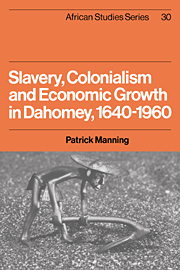Book contents
- Frontmatter
- Contents
- Maps
- Tables
- Figures
- Preface
- 1 Slavery, colonialism and economic growth, 1640–1960
- 2 The Dahomean economy, 1640–1890
- 3 Struggles with the gods: economic life in the 1880s
- 4 Production, 1890–1914
- 5 Demand, 1890–1914
- 6 Exchange, 1890–1914
- 7 The alien state, 1890–1914
- 8 Social struggles for economic ends, 1890–1914
- 9 The mechanism of accumulation
- 10 Capitalism and colonialism, 1915–60
- 11 The Dahomean national movement
- 12 Epilogue
- Notes
- Appendix 1 Export revenue from Dahomey, 1640s–1950s
- Appendix 2 Slave exports by ethnic origin
- Appendix 3 Population loss due to slave exports
- Appendix 4 Foreign trade of Dahomey
- Appendix 5 Foreign trade indices
- Appendix 6 Rainfall
- Appendix 7 Fiscal flows
- Appendix 8 Money supply of colonial Dahomey
- Bibliography
- Index
Appendix 3 - Population loss due to slave exports
Published online by Cambridge University Press: 26 October 2009
- Frontmatter
- Contents
- Maps
- Tables
- Figures
- Preface
- 1 Slavery, colonialism and economic growth, 1640–1960
- 2 The Dahomean economy, 1640–1890
- 3 Struggles with the gods: economic life in the 1880s
- 4 Production, 1890–1914
- 5 Demand, 1890–1914
- 6 Exchange, 1890–1914
- 7 The alien state, 1890–1914
- 8 Social struggles for economic ends, 1890–1914
- 9 The mechanism of accumulation
- 10 Capitalism and colonialism, 1915–60
- 11 The Dahomean national movement
- 12 Epilogue
- Notes
- Appendix 1 Export revenue from Dahomey, 1640s–1950s
- Appendix 2 Slave exports by ethnic origin
- Appendix 3 Population loss due to slave exports
- Appendix 4 Foreign trade of Dahomey
- Appendix 5 Foreign trade indices
- Appendix 6 Rainfall
- Appendix 7 Fiscal flows
- Appendix 8 Money supply of colonial Dahomey
- Bibliography
- Index
Summary
The estimation of decennial rates of population loss requires two sorts of data: population by ethnic origin in each decade, and numbers of slaves exported. The latter are taken from Table A2.1. The former are based on retrospective projections of population growth from base populations of the 1930s, using growth rates selected on an a priori basis. Base populations are taken from the Annuaire Statistique de l'AOF and from Kuczynski's survey of the demography of British colonies. bBase populations for the 1930s are as follows:
Aja–656,000 (all in Dahomey)
Yoruba–3,550,000 (3,400,000 in Nigeria, 150,000 in Dahomey)
Voltaic–610,000 (420,000 in Dahomey, 190,000 in Nigeria)
Nupe–470,000 (all in Nigeria)
Hausa–5,570,000 (all in Nigeria)
No population from Togo was included in the base population, but the inclusion of all Yoruba and Voltaic peoples of Nigeria is a compensating addition. In any case, modern Togo was not as heavily involved in slave trade as surrounding regions. For the Yoruba, Voltaic, Nupe and Hausa populations, common growth rates were assumed: 1.0% per year from the 1870s to the 1930s, and 0.5% per year before the 1870s. Population growth rates in West Africa seem commonly to have been of the order of one percent in the early colonial years, and this growth rate probably preceded the colonial era by some decades. I have assumed a smaller growth rate for earlier years because it is more in line with growth rates known for other areas of the world. Professor Fage has assumed slower growth rates for African population. Perhaps some empirical tests can be devised to estimate African population growth.
- Type
- Chapter
- Information
- Slavery, Colonialism and Economic Growth in Dahomey, 1640–1960 , pp. 340 - 343Publisher: Cambridge University PressPrint publication year: 1982



